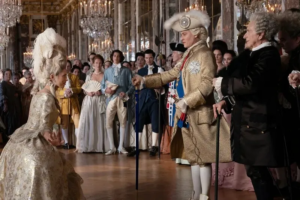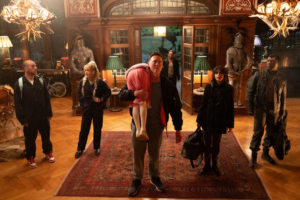Reviewed by GREG KING
Director: Lars Von Trier
Stars: Matt Dillon, Uma Thurman, Bruno Ganz, Siobhan Fallon Hogan, Sofie Grabol, Riley Keogh, Jeremy Davies, Ed Speleers, David Bailie.

Eccentric Danish auteur Lars Von Trier makes controversial and deliberately confronting films, and his latest is likely to be divisive as well. Despite the title, The House That Jack Built is not a family friendly fairy tale. Rather this is Von Trier’s portrait of a sadistic serial killer. But Von Trier’s film is not as illuminating nor as insightful as 1986’s Henry: Portrait Of A Serial Killer that starred Michael Rooker as a drifter who committed brutal murders seemingly with impunity, or Fritz Lang’s classic M.
This is confronting murder porn that follows a serial killer and his 12- year killing spree. It unfolds in five episodes that shaped his notoriety. Jack (played by a game Matt Dillon, from There’s Something About Mary, etc) is an architect and serial killer who is creating his grotesque masterpiece using bodies he has stored in an industrial sized freezer. He coldly kills men, women and children, and there is particularly nasty edge to each of his killings. We get an idea of the in your face level of violence and intensity from the outset when we first see Jack bludgeon Uma Thurman to death using a tyre wrench – a brutal act that is repeated several times with close-ups of the damaged face. Jack shoots, stabs and strangles his victims, and each death becomes more detailed and elaborate in nature. He becomes more creative in his approach as he builds towards his planned perverted opus. Von Trier seems to depict each one with a disturbingly fetishist-like verite style approach, and he seems to revel in the violence.
Jack justifies his actions in a series of voice-over discussions with his mentor Verge (the late Bruno Ganz, best known for playing Hitler in Downfall, in his one of his final film roles), who acts as his sort of moral compass but who is also largely unseen for much of the movie. Jack philosophises about the link between art and violence, the emptiness of modern art, and he talks at length about the impact of Hitler, Stalin, Auschwitz, genocide on humanity. But these philosophical musings probably say more about Von Trier’s world view and misanthropic nature than anything else.
Von Trier’s regular editors Jacob Secher Schulsinger (Nymphomaniac, etc) and Molly Marlene Stensgaard (Dancer In The Dark, etc) incorporate footage of a younger Glenn Gould pounding away at his piano with a rapid-fire montage of paintings, architecture, newsreel footage of twentieth century atrocities and even scenes from the director’s own body of work. Von Trier’s direction is uncompromising, with some extremely graphic violence. And at 150 minutes this soon becomes tiresome and tedious.
As with most of his films, The House That Jack Built has been shot digitally, with lots of hand held camera angles that move in and out of focus. Regular cinematographer Manuel Alberto Claro uses a vaguely different colour palette to separate time frames, and he often works in close-up to depict the killings, and he even creates some grotesque and unforgettable images. Von Trier’s constant use of David Bowie’s Fame establishes a certain mood, and reinforces the idea that Jack desperately seeks acclamation for his actions.
The film features a fearless and committed performance from Dillon, who is largely cast against type here as the cold unrepentant psychopathic killer devoid of emotions and any empathy. His performance is good, and he manages to convey the charismatic Jack’s maniacal mindset, his narcissistic nature and amoral character, and he even captures his touches of OCD. He is a thoroughly unlikeable character and he has few redeeming features. He seems to be channelling notorious serial killers, both real and fictional, from Ted Bundy through to Hannibal Lecter. Some of his victims are portrayed by regular Siobhan Fallon Hogan (Dogville, etc), Sofie Grabol (from tv series The Killing, etc) and Riley Keogh (Elvis’ granddaughter).
The ending of the film goes batshit crazy though as Jack follows Verge into the inner circles of hell in a scene that seems to reference Dante’s Inferno. The House That Jack Built is a visually ugly, thematically vile and morally repugnant film, and very hard to watch. It’s almost as if the director has deliberately set out to push our buttons and provoke an extreme reaction.
One to avoid – unless you’re a fan of Von Trier or a Von Trier completist.
★



